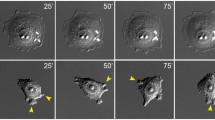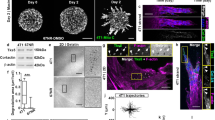Abstract
The invasiveness of MCF-7 human mammary carcinoma cells was tested in vitro via confronting cultures with embryonic chick heart fragments. Invasive (e.g. MCF-7/6) and non-invasive (e.g. MCF-7/AZ) variants were detected. Automated image analysis of time-lapse video-microscopy recordings showed that the plasma membrane ruffling activity of the invasive MCF-7/6 variant was higher than the ruffling activity of the non-invasive MCF-7/AZ variant. Addition of all-trans-retinoic acid to the culture medium (10(-6) M) inhibited both invasion and ruffling of MCF-7/6 cells, while MCF-7/AZ cells became invasive and acquired an increased ruffling by the same type of treatment. A similar opposite effect on MCF-7 cells was not found after treatment with other ligands of the nuclear steroid/thyroid receptor superfamily. Triiodo-l-thyronine (up to 10(-5) M) and beta-oestradiol (up to 10(-6) M) did not alter the invasiveness of the cells, while dexamethasone (10(-6) M) and the pure anti-oestrogen ICI 164,384 inhibited both invasion and ruffling. Our data show that retinoic acid can modulate invasiveness in opposite directions.
Similar content being viewed by others
Author information
Authors and Affiliations
Rights and permissions
About this article
Cite this article
Bracke, M., Van Larebeke, N., Vyncke, B. et al. Retinoic acid modulates both invasion and plasma membrane ruffling of MCF-7 human mammary carcinoma cells in vitro. Br J Cancer 63, 867–872 (1991). https://doi.org/10.1038/bjc.1991.191
Issue Date:
DOI: https://doi.org/10.1038/bjc.1991.191
- Springer Nature Limited
This article is cited by
-
Inhibition of breast cancer cell invasion by melatonin is mediated through regulation of the p38 mitogen-activated protein kinase signaling pathway
Breast Cancer Research (2010)
-
Cell aggregation on agar as an indicator for cell-matrix adhesion: effects of opioids
In Vitro Cellular & Developmental Biology - Animal (2009)
-
The αE-catenin gene (CTNNA1) acts as an invasion-suppressor gene in human colon cancer cells
Oncogene (1999)




